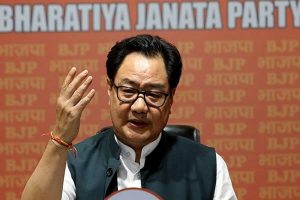The 93rd anniversary of the Salt Satyagraha that lasted for 24 days can provide important lessons for appreciating India’s pluralism of religions, castes, languages, cultures, governance ideologies, and host of other diversities. The 78 trusted volunteers who accompanied Mahatma Gandhi came from various backgrounds and cultural sensibilities.
As a commodity of everyday use, Gandhiji was convinced that salt provided a common rallying point across caste, class, religious and regional identities that made up the diversity of India. As the march progressed, large numbers of people joined the group. And when Gandhiji broke the British Raj salt laws at 8.30 am on 6 April 1930, it led to unified action by millions throughout the country.
Advertisement
From the perspective of the Constitution of India, if the Dandi March created a national space drawing international attention to the freedom struggle, the Republic Day Parade on 26th January each year serves as a powerful expression of the country’s cultural diversity and military might inspiring the masses to serve the nation with the spirit of solidarity.
The Constitution addresses the issues of diversity and pluralism in a number of explicit and specific ways.
� The Preamble to the Constitution (particularly the terms ‘secular’, ‘democratic’, ‘liberty of thought, expression, belief, faith and worship’ and ‘fraternity’);
� Detailed provisions on federalism [for example, Articles 245 to 263 of the Constitution] and multilingualism [Articles 343 to 351];
� Individual fundamental right to equality and equal opportunity (including prohibitions on discrimination based on religion, race, caste, sex, place of birth) [Articles 14, 15 and 16], the fundamental right to freedom of speech [Article 19(1)(a)], the freedom of religion and to manage religious affairs and institutions [Articles 25, 26, 27, 28 and 30], the fundamental right to conserve distinct languages, scripts or culture including through educational institutions [Articles 29 and 30] etc.;
� Directive principles of state policy including the principle that the “State shall, in particular, strive to minimise the inequalities in income, and endeavour to eliminate inequalities in status, facilities and opportunities, not only amongst individuals but also amongst groups of people residing in different areas or engaged in different vocations” [Article 38(2)];
� The fundamental duties of every citizen of India which include: “to promote harmony and the spirit of common brotherhood amongst all the people of India transcending religious, linguistic and regional or sectional diversities; to renounce practices derogatory to the dignity of women” and “to value and preserve the rich heritage of our composite culture” [Articles 51-A(e) and (f)].
At the outset, it is important to recognise that diversity and pluralism are recognised through at least three (there may be more) distinct forms in the Indian Constitution. First, elements and values that pertain to the State identity: this includes, for example, democracy, secularism, republicanism, federalism, and multilingualism; second, fundamental rights and fundamental duties that pertain most directly to the individual, and, third, political and cultural rights that pertain most directly to identity-based groups (based on religion, caste, language, and so on).
Despite the wisdom of the constitutional text on diversity and pluralism, a number of extremely difficult challenges and new realisations have arisen, both in India and across the world, in the years since India achieved independence. These situations and tendencies call for a response that is not to be found easily in the text of the Constitution, and this is where one must recognise the remarkable role of the Indian judiciary (particularly the Supreme Court and several distinguished High Courts) in courageously responding to a number of specific areas that involved questions of diversity and pluralism.
To give some examples, issues of secularism, caste discrimination, gender equality and freedom of sexuality, freedom of speech and expression including questions of obscenity and hate speech, environment and biological diversity, and federalism have received careful attention from learned judges who have provided us with a number of principles and precedents that help resolve difficult questions of diversity and pluralism in particular contexts. We owe much to the judiciary in India, with some exceptions, when it comes to our overall clarity on related ideas of fairness, of tolerance, of non-discrimination, of reasonableness, of multiculturalism, of mutual respect, etc. that play out in scenarios of diversity such as those found in India.
To cite one example, let me share a few excerpts from the judgement delivered by Supreme Court of India Judge D. M. Dharmadhikari on 12 September 2002 on the subject of ‘religious education’ in non-minority educational institutions. “…Secularism is the basic structure of the Constitution… The words ‘religious instructions’ have been held as not prohibiting education of religions dissociated from “tenets, the rituals, observances, ceremonies and modes of worship of a particular sect or denomination”.
The academic study of the teaching and the philosophy of any great Saint such as Kabir, Guru Nanak and Mahavir was held to be not prohibited by Article 28 (1) of the Constitution. A distinction, thus, has been made between imparting “religious instructions” that is teaching of rituals, observances, customs and traditions and other non-essential observances or modes of worship in religions and teaching of philosophies of religions with more emphasis on study of essential moral and spiritual thoughts contained in various religions.
There is a very thin dividing line between imparting of ‘religious instructions’ and ‘study of religions’. Special care has to be taken of avoiding possibility of impairing ‘religious instructions’ in the name of ‘religious education’ or ‘Study of Religions’.
The English word ‘religion’ does not fully convey the Indian concept of religion. Hindus believe in Vedas. The word ‘Dharma’ has a very wide meaning. One meaning of it is the ‘moral values or ethics’ on which the life is naturally regulated. Dharma or righteousness is elemental and fundamental in all nations, periods and times. For example, truth, love, compassion are human virtues. This is what Hindu call Sanatan Dharma meaning religion which is immutable, constant, living permanent and ever in existence. Religion, in a wider sense, therefore, is those fundamental principles which sustain life and without which the life will not survive… This distinction between ‘religious instructions’ and ‘religious education’ has to be maintained while introducing a curriculum of religious education and implementing it. This would require a constant vigil on the part of those imparting religious education from primary stage to the higher level otherwise there is a potent danger or religious education being perverted by educational authorities.
Religious education in the true sense is to encourage the child to understand his own relationship to people, to things and to nature. There is no existence without relationship, and without self-knowledge. Religious education, therefore, even if permitted to be imparted should consist of “understanding the child as he is without imposing upon him an ideal of what we think he should be.”… An educator is not merely a giver of information; he is one who points the way to wisdom, to truth. Truth is far more important than the teacher. The search for truth is religion, and truth is of no country, of no creed, it is not to be found in any temple, church or mosque. Without a search for truth, society soon decays.
In a pluralistic society like India which accepts secularism as the basic ideology to govern its activities, education can include study based on ‘religious pluralism’. ‘Religious pluralism’ is opposed to exclusivism and encourages inclusivism. The comprehensive approach to religion which should be inculcated in a society comprising people of different religions and faiths is described as inclusivism.
A wider acceptance of pluralist view of the religious life of humanity must involve developments in the selfunderstanding of each tradition, a modification of their claims to unique superiority in the interests of a more universal conception of the presence of the Real to the human spirit. The attainment of constitutional ideals is possible only if side by side with sharpening intellect, the moral character of children is also developed to make them good citizens.
The real meaning of secularism in the language of Gandhi is Sarva-Dharma-Samabhav meaning equal treatment and respect for all religions, but we have misunderstood the meaning of secularism as negation of all religions. The result of this has been that we do not allow our students to even touch our religious books. Gandhiji in his lifetime had been trying to create religious and communal harmony and laid down his life in doing so.
Despite the G20 presidency motto of Vasudhaiva Kutumbakam (one planet, one family, one future), questions of diversity and pluralism continue to pose a number of challenges in India and across the world today. Three most pressing challenges include:
� The resurgence of fanatical religious fervour occurring in different countries is not simply a sign of dying convulsion. The very nature of the violent and disruptive phenomena associated with it testifies to the perversion of the fundamental truths as enshrined in the Sacred Scriptures. Those who have held blindly and selfishly to their particular orthodoxies are responsible for the conflicting interpretations and for disrupting the culture of liberty, tolerance and mutual respect that have been the mainstay of our constitutional approach to diversity and pluralism.
� The economic and social challenges and the new questions raised by the global refugee and ecological crises – these are, in part, produced by a poor or faulty political and legal approach towards diversity and pluralism.
� Cultures and technologies that disrupt or challenge mainstream ‘Bharatiya’ notions of culture and sensibility. For example, ‘hate’ speech and fake news through social media, public articulations of alternate sexualities, claims for genuine and not merely formalistic gender equality, and so on. Salt Satyagraha and the Gandhian approach to non-violent protest and dissent, people-centric economics, environmental conservation, and adherence to moral principles provide important lessons. In recent studies, suggestions are being made to revisit Gandhian pathways and alternatives. While the world is acknowledging their relevance, India is losing the essence of Gandhi.
(The writer is a social worker and independent researcher providing his services to a number of non-governmental organizations and governmental institutions. Views expressed are personal.)
















